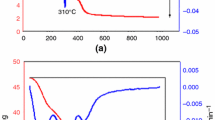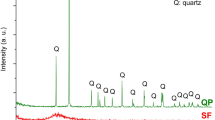Abstract
This investigation aimed to develop structural blended cement pastes with high mechanical properties for building envelope purposes. The effect of nano silicate (NS) replacement on the properties of blended white cement pastes as compared with the control paste have been studied through the measurements of indirect tensile strength (ITS). NS was thermally activated at 850 °C for 2 h and used to partially replace Portland white cement (PWC) at different ratios. The activation effect of NS on the ITS have also been studied. The cement pastes were prepared using water of consistency. The pastes were removed from the mold after 24 h and then immersed in a water bath for hydration. The 7-day aged pastes were tested after drying for 24 h at 105 °C. Different physical properties such as thermal resistivity, solar reflectivity, water absorption and apparent porosity were measured. It was found that, activation of NS decreases the porosity allowing the blended cement paste to be denser, consequently increasing the ITS. Increasing the replacement content of unactivated NS upto 2%, improved the ITS by about 40% compared with the control paste. Also, the thermal activation of the NS has a very good influence in enhancing the ITS to about 50% with respect to the 2% unactivated blended paste. The results also showed that increasing the replacement content generally increases the water absorption and the porosity of blended white cement pastes, while, slightly improving the thermal resistivity. Activation of NS reduced the solar reflectivity of blended pastes as compared with unactivated blended pastes. An optimum replacement of around 2% can be concluded from the current work.



Similar content being viewed by others
References
Yilmaz B, Olgun A (2008) Cem Concr Compos 30:194
Voglis N, Kakali G, Chaniotakis E, Tsivilis S (2005) Cem Concr Compos 27:91
Morsy MS, Shebl SS (2007) J Ceram Silicaty 51:40
Qing Y, Zenan Z, Deyu K, Rongshen C (2007) Construct Build Mater 21:539
Jo BW, Kim CH, Tae GH, Park JB (2007) Construct Build Mater 21:1351
Li H, Xiao HG, Yuan J, Ou J (2004) Compos Part B: Eng 35:185
Li G (2004) Cem Concr Res 34:1043
Morsy MS, Aglan HA (2007) J Mater Sci 42:10188. doi:https://doi.org/10.1007/s10853-007-1981-3
Campillo I, Guerrero A, Dolado JS, Porro A, Ibanez JA, Goni S (2007) Mater Lett 61:1889
Shih JY, Chang TP, Hsiao TC (2006) Mater Sci Eng 424:266
Arikan M, Sobolev K, Ertun T, Yeginobali A, Turker P (2009) Construct Build Mater 23:62
Katsioti M, Giannikos D, Tsakiridis PE, Tsibouki Z (2009) Construct Build Mater 23:1011
Bougara A, Lynsdale C, Ezziane K (2009) Construct Build Mater 23:542
Saraswathy V, Song HW (2006) Electrochimica Acta 51:4601
Saraswathy V, Muralidharan S, Thangavel K, Srinivasan S (2003) Cem Concr Compos 25:673
Samet B, Mnif T, Chaabouni M (2007) Cem Concr Compos 29:741
Blanco F, Garcia P, Mateos P, Ayala J (2000) Cem Concr Res 30:1715
Demirboga R (2003) Energy Build 35:189
Heikal M, Morsy MS, Aiad I (2005) Cem Concr Res 35:680
Fu X, Chung DDL (1997) Cem Concr Res 27:1799
Sabine Care (2008) Construct Build Mater 22:1560
ASTM E1530-04 (2004) Standard test method for evaluating the resistance to thermal transmission of materials by the guarded heat flow meter technique. ASTM International. https://doi.org/www.astm.org
ASTM C140-01 (2001) Standard test method for sampling and testing concrete masonry units and related units. ASTM International. https://doi.org/www.astm.org
Acknowledgements
Partial support for this project came from ORNL through the DHS resilient home Program. Lehigh Cement is acknowledged for providing materials used in this study. Aldinton Allie and Maria Calhoun are also acknowledged for assisting with the mechanical tests and the SEM pictures, respectively.
Author information
Authors and Affiliations
Corresponding author
Rights and permissions
About this article
Cite this article
Shebl, S.S., Allie, L., Morsy, M.S. et al. Mechanical behavior of activated nano silicate filled cement binders. J Mater Sci 44, 1600–1606 (2009). https://doi.org/10.1007/s10853-008-3214-9
Received:
Accepted:
Published:
Issue Date:
DOI: https://doi.org/10.1007/s10853-008-3214-9




